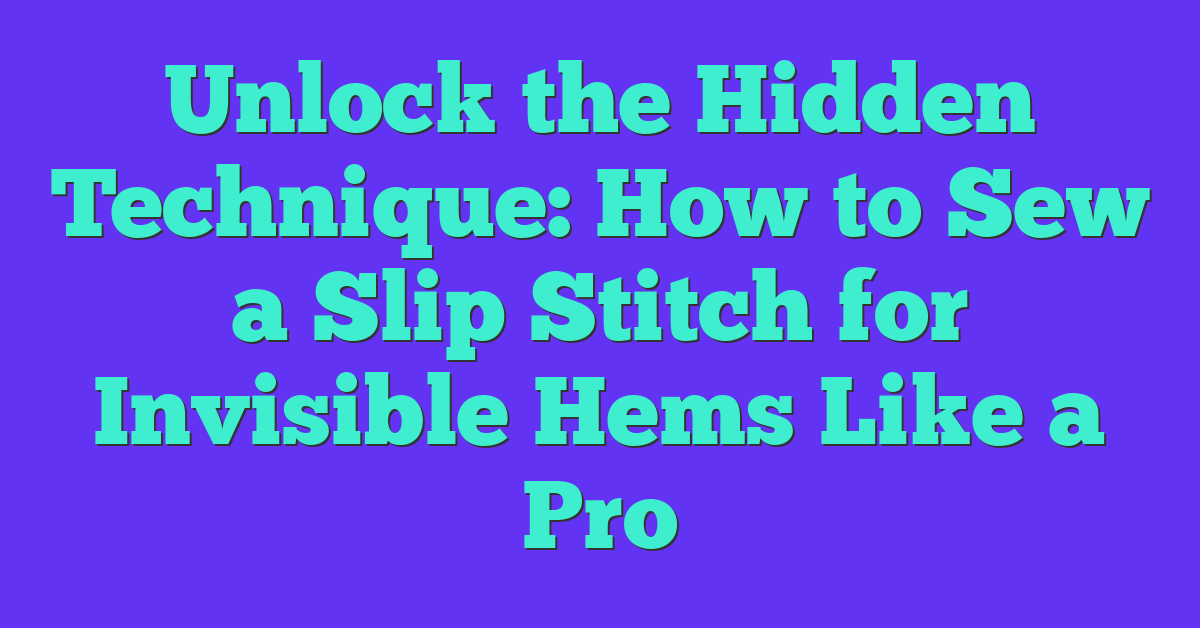Ever struggled with visible hems that ruin the polished look of your garments? I’ve been there too. Sewing a slip stitch is a game-changer for achieving those seamless, invisible hems we all crave.
Understanding Invisible Hems
Invisible hems create a seamless finish by concealing the raw edge of fabric inside the garment. Achieving this look enhances the overall appearance, making the hem appear professionally crafted. Different fabrics require specific techniques to ensure the hem remains undetectable. For example, lightweight materials like silk benefit from precise stitching, while heavier fabrics like denim need secure, concealed seams. Invisible hems are ideal for skirts, dresses, and trousers, providing a polished and tidy edge. Additionally, they prevent fraying, extending the garment’s lifespan and maintaining its pristine look over time.
Tools and Materials Needed
To sew a slip stitch for invisible hems, gather the following tools and materials:
- Tailor’s needle: Use a fine needle suitable for your fabric type.
- Thread: Choose a color that matches your garment for seamless stitching.
- Scissors: Sharp fabric scissors ensure clean cuts.
- Pins or needle threader: Secure the hem in place before stitching.
- Iron: Press the hem to create a crisp edge.
- Seam ripper: Optional tool for correcting any stitching mistakes.
- Measuring tape: Accurate measurements help achieve even hems.
Having these tools and materials ready ensures a smooth and efficient hemming process, resulting in professional-looking invisible hems.
Step-by-Step Guide to Sewing a Slip Stitch
Creating an invisible hem with a slip stitch is straightforward once you follow these steps. Here’s how I achieve seamless, professional-looking hems every time.
Preparing the Fabric
Before sewing, I prepare the fabric to ensure a smooth and accurate hem. I start by measuring the desired length and marking it clearly.
- Measure Precisely: Use a measuring tape to determine the exact hem length for skirts, dresses, or trousers.
- Mark the Fabric: Apply fabric chalk or pins to indicate the hemline, ensuring consistency across the garment.
- Press the Hem: Iron the marked line to create a crisp folding edge, making it easier to sew accurately.
Making the Slip Stitch
Executing the slip stitch requires patience and precision to maintain the invisibility of the hem.
- Thread the Needle: Select a matching thread color and thread a tailor’s needle, tying a secure knot at the end.
- Begin Stitching: Insert the needle into the folded edge from the inside of the fabric, making small, even stitches about 1/8 inch apart.
- Maintain Consistency: Keep the stitches tight and hidden within the fabric layers, ensuring the hem remains invisible from the outside.
Finishing the Hem
Completing the hem properly ensures durability and a professional finish.
- Secure the Stitch: Tie a small knot at the end of your stitches to prevent them from unraveling.
- Trim Excess Thread: Carefully cut any excess thread close to the knot without cutting the fabric.
- Press Again: Iron the hem once more to set the stitches and finalize the neat appearance.
Tips for a Professional Look
- Use High-Quality Thread: Match thread color precisely to fabric, preventing visibility and ensuring a seamless appearance.
- Maintain Even Stitches: Space stitches consistently 1-2 mm apart, enhancing uniformity and concealment.
- Press Thoroughly: Iron the hem before stitching to set the fabric and after stitching to secure the hem neatly.
- Choose Sharp Tools: Employ sharp scissors and quality needles to prevent fabric damage and facilitate smooth stitching.
- Practice on Scrap Fabric: Test your slip stitch technique on similar fabric pieces, perfecting your method before working on the garment.
- Secure the Ends: Finish with small, tight knots, preventing stitches from unraveling and maintaining hem integrity.
Common Mistakes to Avoid
- Uneven Stitches: I maintain consistent spacing of 1-2 mm between stitches. Inconsistent stitching makes the hem visible and unprofessional.
- Mismatched Thread: I select thread that matches the fabric color exactly. Using contrasting thread reveals the stitches and detracts from the invisible look.
- Skipping Hem Pressing: I press the hem before and after stitching. Neglecting this step results in a wrinkled and uneven hem.
- Not Securing Stitch Ends: I tie small, tight knots at the end of my stitches. Leaving ends unsecured can cause the hem to unravel over time.
- Using Dull Tools: I use sharp scissors and needles for precise stitching. Dull tools can damage the fabric, making the hem less smooth and more noticeable.
- Improper Fabric Preparation: I measure, mark, and press the fabric accurately before stitching. Skipping these preparation steps leads to misaligned and uneven hems.
Conclusion
Mastering the slip stitch has truly transformed how I handle hemming. Seeing the invisible finish on my garments brings a sense of accomplishment every time. It’s amazing how a few simple steps can make such a big difference in the overall look of my clothes. I love that this technique not only enhances the appearance but also extends the life of my favorite pieces. Sewing invisible hems has become a go-to skill in my crafting toolkit, allowing me to take pride in every stitch. Whether you’re a beginner or have some experience, giving the slip stitch a try can elevate your sewing projects to a professional level. Happy sewing!

















